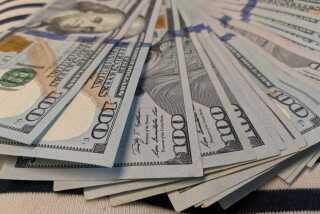Odds Good to Halt Dollar’s Slide
- Share via
The rise and fall of the dollar in foreign exchange markets has been a spectacular feature of economic performance this decade. It has been a boon to many speculators and, at times, a preoccupation of policy-makers.
In September, 1985, economic officials from the major industrial nations agreed the dollar had risen too far and organized a concerted effort to bring it down. Private market forces, which already had started depreciating the dollar from its peak of the previous spring, kept pulling it down during 1986 and early this year.
Recently, policy-makers both here and abroad have agreed that the dollar has fallen far enough. But unlike 1985, when the private market agreed with policy-makers, most economic analysts think--in my opinion, wrongly--that the dollar must continue to fall.
Can policy-makers succeed in halting the dollar’s decline if private sector experts believe it must fall further? If so, they will have to do it with limited tools. Governments have only a few options for supporting the dollar.
They can intervene directly in foreign exchange markets, buying dollars with other currencies and thus directly increasing the demand for dollars. Also through government action, U.S. interest rates can be lifted relative to rates abroad, thus making dollar investments more attractive for international investors. Finally, by demonstrating their determination to support the dollar, government officials can influence market expectations and, in turn, strengthen demand for the currency.
Most analysts doubt that direct intervention alone can accomplish much. They assume that exchange rates are determined largely by so-called economic fundamentals, the most obvious of which is a nation’s trade balance.
Thus, if a country’s present and prospective trade deficits look too large to support existing exchange rates, the market will conclude that the currency eventually will have to fall to improve the balance of trade.
Deficit Is Key Factor
The reason most experts project a further fall in the dollar is that they believe the U.S. trade deficit, roughly $170 billion last year, cannot be eliminated at the current exchange rate.
Once such a belief, based on economic fundamentals, dominates the markets, owners of private capital who fear that the currency will decline start shifting their investments elsewhere, reducing the demand for dollars and pushing down the currency.
Official intervention in currency markets can slow this decline or arrest it for a time but not permanently change its course.
Intervention mainly will allow private investors to move out of dollars on more attractive terms because central banks are willing to buy them.
Higher interest rates can offset some of the pressure on a currency from economic fundamentals such as trade deficits. They offer some inducement to investors to stay in the currency despite the risk that it will depreciate.
However, if the balance of expectations shifts strongly against the currency, a modest interest rate advantage will not justify the gamble of continuing to hold dollars. For example, over the past two years, the dollar has fallen by more than 40% against the Japanese yen and the West German mark. If investors had known this would happen, would it have made sense for them to keep their capital in U.S. bonds paying only 3% or 4% more than foreign bonds?
May Be Successful
On the other hand, if the markets are somehow convinced that the risk of further dollar decline is modest, then the ability to earn an extra 3% to 4% by investing in U.S. rather than foreign bonds would attract capital to this country. That, in turn, would strengthen the dollar.
Fortunately for U.S. policy-makers, today’s economic circumstances suggest that government may be able to support the dollar successfully. That is largely because of uncertainty about whether correcting the trade deficit will require a further decline of the dollar.
In 1985, it was clear that future trade deficits would be unsustainably large. Now, however, there are questions: How much improvement in the trade balance eventually will be achieved by the dollar’s decline to date? And how can you isolate the impact of the dollar’s fluctuations?
Many factors besides exchange rates enter trade balance projections, including growth rates in Europe and Japan, how the Latin American debt crisis is resolved and the extent to which the Pacific Basin countries open their markets to U.S. exports.
Moreover, recent data shows the beginning of improvement in U.S. trade accounts. After ever-larger deficits for five years, the trade account seems to be heading in the other direction.
Given the lack of a clear outlook for the future of the nation’s balance of trade, this shift in the numbers should be enough to raise doubts about whether the dollar will face further downward pressure from economic fundamentals. Even if most analysts believe that the dollar will continue to fall, the investors who move the markets will have little confidence in that assessment.
Consequently, policy-makers have an excellent opportunity to influence the financial markets. It is likely that they now can arrest the dollar’s decline.
More to Read
Inside the business of entertainment
The Wide Shot brings you news, analysis and insights on everything from streaming wars to production — and what it all means for the future.
You may occasionally receive promotional content from the Los Angeles Times.










